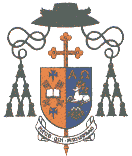PARISHES OF DRUMGOOLAND
Lower Drumgooland & Upper Drumgooland
by Michael McCartan
Until about the year 1784, there was only one parish
in the area known as Drumgooland. From around that time two separate
parishes were formed and ever since have been known as Upper and Lower
Drumgooland. It is proposed here to present an outline history of the
united parish. This will be followed by summary accounts of the main
events and highlights of parish life in the two entities plus a record
of their parish priests.
The ancient Parish of Drumgooland lies along part of
the eastern boundary of the Diocese of Dromore within easy reach of the
majestic Mourne mountains to the south and the smaller Slieve Croob to
the north. Dechomet Mountain almost touches on its western boundary
while Castlewellan is very near its eastern extremity. The original
parish occupies a considerable portion of land, a large portion of which
was reasonably flat and fertile and a smaller area which was more hilly
and barren.
The land quality in this part of County Down must
have been a factor in attracting some of its earliest settlers because
as far back as 1,500 B.C, the Beaker people, a Bronze Age tribe, left
traces of their settlement at Closkelt townland on what much later
became the western border of the old Parish of Drumgooland. The presence
of an ancient High-Cross which formerly stood in Drumadonnell townland,
is the only visible trace of early Christianity in the area, prior to
the establishment of the parish system. In medieval times the parish
formed but a small part of the Magennis territory known as Iveagh. As
will be seen, the Reformation of the sixteenth century had important
implications, both nationally and locally, for those who chose to remain
Catholic. During the seventeenth and eighteenth centuries the parish
felt the impact of political turmoil which brought changes in
land-ownership and hastened the arrival of English and Scottish
newcomers, replete with their cultural and religious differences.
ORIGINS AND EARLY CLERGY
The origin of Drumgooland Parish is by no means
certain. The earliest known reference to it is to be found in the
Calendar of Papal Letters which records Tiernacus O'Ronaga (O'Rooney)
as Vicar of Drumgolyn (Drumgooland), who died circa. 1419 and was
succeeded by Patrick O'Ronaga on the 17th. January 1420. Donald Makartan
was Rector of the Parish when he died in 1422 and was replaced by
Magnellus O'Ronaga. According to Cromer's
Register, Gelacius O'Makrell became Vicar of Drumgooland in 1529 on
the death of William O'Ruonaghe and was followed in this post by Arthur
O'Runaga. For the next 120 years there are no known records of the
priests of the parish.
Although there are now no structural remains, strong
local tradition and some documentary evidence would locate
pre-Reformation church sites in the townlands of Legananny, Magheramayo,
Dechomet and Drumnadonell. The archaeologist, Dr. Ann Hamlin, believed
that the cross-carved pillar stone at Legananny, which stands at the
head of a small graveyard mound, is a likely church site, as is
Drumadonnell - the probable original location of the ancient High-Cross.
In the mid-19th. century, the antiquarian, Dr. William Reeves,
documented the ruins of an old church at a place known as Shankill, in
Magheramayo townland, and an ancient cemetery in the townland of
Dechomet, where the ruins of an old church formerly stood.

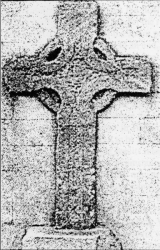
Ancient High Cross of Drumadonnell
The impact of the Reformation along with the
political upheaval of the seventeenth century had long term implications
for the Catholic Church at national and local level. Protestantism was
now the official state religion and Catholic churches and their lands
passed into the hands of the Reformed Church or fell into disuse. Penal
legislation sought to reduce the numbers of the clergy and severely
restricted the freedom of the laity to openly practise their religion.
In Drumgooland, the practical outcome of these developments was the
insufficient supply of trained clergy and the loss of places of worship.
In terms of church buildings, the western end of the
parish was particularly badly affected. Drumnadonnell passed into the
ownership of the Established Church and the site at Dechomet was
reputedly destroyed by Cromwellian forces. There is no strong oral
tradition to account for the demise of Legnanny and Magheramayo
churches. It is therefore not surprising that the practice of the priest
celebrating Mass in the open, at some secluded spot in the countryside,
first became a necessity at this time. In Drumgooland, a number of
Mass-sites have been identified. The best known is the Rock on
Ballymagreehan mountain where Mass has been celebrated in recent years.
The townland of Gargory once had a Mass-bush, while another Mass rock
was located in Backaderry townland.
From the surviving records it is clear that there
were very few priests available to minister to the faithful of the
parish during the seventeenth century. In fact, only three priests are
recorded for this period. Fr. Cahal MacRory, a poet of much beauty of
expression, was Parish Priest in 1650. Fr. Patrick Matthews was Pastor
in 1681 and Fr. Hugh O'Shiel, outlawed for his support of King James
during the Williamite wars, was Parish Priest of Drumgooland from
1691-1704. During the first half of the eighteenth century, church
organisation and religious practice were at their weakest, under the
weight of penal legislation and official harassment. From 1704-1741, Fr.
Patrick Byrne was the only named priest in the parish. Fr. Terence
O'Fegan was the only named priest in the parish in 1742 and Fr. Michael
Morgan, who became involved in a lengthy dispute with the church
hierarchy, was Parish Priest in the 1760s, and possibly at a later
period. The last Parish Priest of the undivided parish seems to have
been Fr. Nicholas Woods.
Resurgence
The easing of penal restrictions, especially the
repeal of the laws against the clergy in the last quarter of the
eighteenth century, coincided with signs of revival

and renewal in the parish of Drumgooland. Admittedly,
the dispute over clerical jurisdiction created a poor impression,
however, on the appointment of Doctor Matthew Lennon as Bishop of
Dromore in 1780, there were signs of positive change and development.
Within four years of his appointment, Bishop Lennon had established two
Parishes in Drumgooland - Lower Drumgooland, which was located in the
Western sector of the old parish, and Upper Drumgooland, which would
occupy the eastern half. From this moment onwards, both parishes would
be fully supplied with trained clergy, better prepared to meet the
pastoral challenges that now confronted them.
The emerging self-confidence of the Catholic
community in both parts of Drumgooland after its division, is best
represented by its almost instant resolve to embark on a much needed
church building programme. Not only did this initiative serve to
stimulate the faithful, but is also presented a strong outward sign of
the revitalisation and permanency of the Catholic institution and ethos,
following a long period of uncertainty. As will be seen, a new church
was erected in Upper Drumgooland as early as 1786 and later upgraded and
enlarged in 1835. In Lower Drumgooland, the need was not as urgent, as
some form of church building was already in place at Gargory.
Nevertheless, a new chapel was built and in use at Dechomet by 1803, to
cater for the large congregation at the western end of this expansive
parish. The erection of two fine new churches, firstly, at Gargory in
1855, and then at Leitrim in 1871, is a lasting testament to the
dedication and commitment of both priests and people of the two
parishes.
THE UNEVEN DIVISION OF THE
PARISH
- A POSSIBLE EXPLANATION!
There were nineteen townlands in the united Parish of
Drumgooland. When the two new parishes were established in 1784, Lower
Drumgooland appears to have been comprised of thirteen townlands,
whereas, Upper Drumgooland, with only six townlands, had less than half
that number. This was a very unequal division and requires an
explanation. The answer may be found in the solution arrived at by the
ecclesiastical authorities, to end the dispute in Drumgooland Parish
during the 1760s.
Put simply, the dispute involved two priests who were
claiming jurisdiction in the parish at the same time. Fr. Michael Morgan
claimed he was the lawful pastor and that an intruder, Fr. Rooney, was
maintaining himself on the parish and collecting a stipend from part of
it. To resolve the dispute, Anthony Garvey, Bishop of Dromore, was
instructed in 1762, to divide the parish. The terms of settlement were
that Fr. Rooney would he assigned an area within the parish, sufficient
to maintain him, and Fr. Morgan would be prohibited from collecting
within its limits. Fr. Morgan would continue to have control over the
rest of the parish.
However, Bishop Garvey died in 1766 before the
division was formally ratified. The new arrangement was not officially
implemented until 1784, four years after the appointment of Dr. Matthew
Lennon as Bishop of Dromore. Is it possible that in anticipation of an
officially sanctioned division of the parish, a loose arrangement, based
on the intended official solution, was implemented soon after the
pronouncement of 1762? That this may have been so, is indicated by the
sudden ending of the quarrel over jurisdiction between Fr. Morgan and
Fr. Rooney.
It is not clear why it took so long to formally
divide Drumgooland. The delay may have been connected to the appointment
of Regular Clergy rather than Diocesan Clergy to the Bishopric of
Dromore between 1766 and 1780. The Friar-bishops may have been reluctant
to tamper with such sensitive issues as parish boundaries and structures
which could be better handled by a bishop from a diocesan background.
When Bishop Lennon, a member of the diocesan clergy, finally made the
decision in 1784, it is assumed he was reluctant to change what had
probably been in place and was functioning smoothly for more than twenty
years. This may be the reason why the smaller portion of the parish,
originally allocated to Fr. Rooney back in 1762, became, in 1784, the
new Parish of Upper Drumgooland. Significantly, it was Fr. Rooney who
became its first Parish Priest.

THE PARISH OF LOWER DRUMGOOLAND
The Parish comprises 13 townlands - Ballydrumman,
Ballymacareney, Ballymaginthy, Ballyward, Clanmaghery, Closkelt,
Dechomet, Derryneil, Drumadonnell, Drumlee, Gargory, Magheramayo and
Moneyslane.
Lower Drumgooland has just over double the number of
townlands contained in Upper Drumgooland.
According to the 1841 census, Lower Drumgooland had a
population of 6,973. Dechomet was the most popular townland with 780
inhabitants.
During the 1830s, average Mass attendance was 600 in
Dechomet, and 500 in Gargory.
GARGORY CHURCH BEFORE 1855
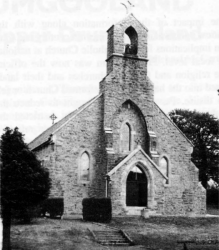 |
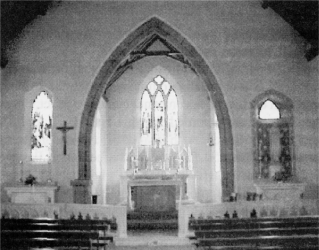 |
|
St. Patrick's Church, Gargory, was built
in 1855. It is believed to have replaced an older church in
this locality. The most recent work on St. Patrick's saw the
sanctuary and the baptistery renovated in 1997. |
Recent accounts of Drumgooland's Parish history tend
to focus on the new church built at Gargory in 1855, but pay scant
attention to the church it replaced. Although somewhat tenuous, there
are grounds for believing that a church was built there as far back as
1760, or even earlier, thus pre-dating by some 25 years, the erection of
the first church at Leitrim.
When the Ordnance Survey team visited the Parish in
the 1830s, they described the church at Gargory as, "a plain building of
un-hewn stone, 63 feet long and 25 feet broad". The surveyors were
unable to ascertain when the church was built or set an estimate for the
cost of construction. One reason for this may have been that the church
was built beyond the memory of the-older inhabitants of the
Parish.
The Vatican Documents detailing the Fr. Morgan
dispute, recorded the existence of a chapel in the undivided parish in
the early 1760s. As there are no records of churches at Leitrim or
Dechomet prior to 1786, it is conceivable that the church referred to in
the documents is the one at Gargory, described by the Ordnance Survey
team in the 1830s. If this assumption is correct, then this was the
first Catholic church built in the undivided Parish since the
Reformation.

GARGORY
Initiatives and Milestones
|
1784: |
Parish of Lower Drumgooland established. A
rudimentary church must have stood at, or near, the site of
the present church. |
|
1823-24: |
First school-house built at Magheramayo. |
| 1825: |
Second school-house opened.These two
buildings served the Gargory end of the parish for nearly
130 years. |
| 1840-45: |
Fr. Morgan built the parochial house beside
the church. |
| 1849: |
Church damaged by Orangemen during the
Dolly's Brae Affray. |
| 1855: |
Present Church of St. Patrick erected by
Rev. Bernard Hughes.
Church hell erected around this time. |
| 1912: |
Minor alterations to the church by Fr.
McKinney. |
| 1915: |
Rev. Edward McCartan, P.P. Seagoe, a native
of Lower Drumgooland, expended �1,600 pounds, renovating and
enriching the church. He installed a marble altar, marble
railings, mosaic floor in chancel, ornamental windows and a
gallery. |
| 1920-24: |
Church further adorned by the addition of
the following:
Our Lady's Altar, at a cost of �100 - was the gift of Mrs.
McGorrian, Gargory.
Sacred Heart Altar, costing �70 - bequeathed by Rev. Peter
McEvoy, RP., Dromara, a native of the parish.
Stations of the Cross, presented by Patrick Keenan,
Magheramayo.
Holy Water fonts, the gift of Hugh Smyth. Altar charts,
presented by Mrs. McEvoy, Ballymagreehan.
Confessional boxes, presented by Arthur McCrickard,
Moneyscalp, Kilcoo. |
| 1940-41: |
Further alterations to the church -
undertaken by Dr. Michael O'Hare P.P., who also installed
electric light. |
| 1953: |
New Primary School opened at Magheramayo,
1st. December. |
| 1958-64: |
Fr. Patrick Boyd, P.P., had a new floor
fitted in vestry of St. Patrick's Church. |
|
1965-74: |
Fr. J.J. Pettit P.P., changed altar to
conform to Vatican II regulations. Central heating
installed, church floor carpeted and new porch erected. |
| 1981: |
Fr. Liam Boyle P.P., re-roofed and re-wired
St. Patrick's Church. |
| 1997: |
On the 5th. October, church re-opened after
extensive renovations. Mass celebrated by Archdeacon Liam
Boyle P.P., with Very Rev. John Kearney Adm., Newry, the
preacher and Fr. Lionel Murray Adm., Leitrim as
concelebrant. |

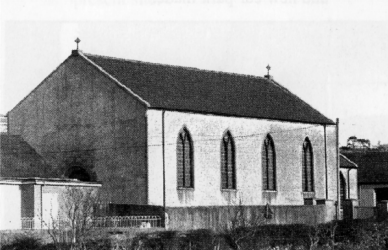
The Church of St. Mary of the Angels,
Dechomet, was begun in 1822. A smaller church had
existed on the same site since 1803. The adjoining
cemetery has been in use since 1848.
Initiatives and Milestones
| 1803: |
Small church erected on site of present
church by Fr. Bernard Magennis. |
| 1808: |
Further improvements to church by Fr. Peter
McCarthy P.P. |
|
1822-32: |
Fr. Thomas McKay P.P., commenced
construction of new church on original site. He died before
its completion. |
| 1834: |
First school in Dechomet, erected by Dr.
Patrick Morgan P.P. |
| 1835: |
Work on new Church of St. Mary of the
Angels completed by Dr. Patrick Morgan P.P., and dedicated
by Bishop Blake on the 2nd. October.
Ordnance Survey memoirs description of church:- "A plain
rectangular building of un-hewn stone, slated and in good
order. Built by private subscription. It is 71.5 feet long
and 33 feet broad." |
| 1837: |
Dechomet School came under control of
National Education Board. |
| 1848: |
Fr. Morgan P.P., purchased plot of land
beside church for use as new burial ground The old
Drumgooland Cemetery had been used up to this time and was
used for some years afterwards. |
|
1856: |
Fr. Bernard Hughes P.P., added a room to
Dechomet School and added a bell at the church around this
time. |
| 1965: |
On 23rd. August - New Primary School |
|
1971: |
Fr. Pettit RP., extensively renovated
church at approximate cost of � 10,000 - thanks to voluntary
work of parishioners. Altar move( from gable to left side of
church. Choir anc confessionals placed on opposite side. New
organ and seats installed.
Church blessed and rededicated by Bishop O' Doherty.
About the same time, cemetery improved and new car-park
made. |


The interior of St. Mary's, Dechomet. The
Church was rededicated on Sunday, 14th. November 1971 by Bishop
O'Doherty. It had been extensively renovated, at a cost of
�10,000.
LOWER DRUMGOOLAND - PARISH PRIESTS
The Rev. Nicholas Woods (1784 - 1808), was apparently
the last Parish Priest of the undivided Parish and the first parish
priest of Lower Drumgooland. He died in 1803 and was succeeded by
Rev. Bernard Magennis (1803-1806), who built the first small chapel
on the present site at Dechomet. Prior to his appointment to Lower
Drumgooland, Fr. Magennis had been interned in Carrickfergus
Castle for almost four years on suspicion of involvement in the 1798
rebellion. He was released without charge in January 1802 and, for the
remainder of his life, was a committed supporter of the struggle for
Catholic Emancipation.
The Rev. Peter McCarthy (1806-1817), the next
Parish Priest, continued improvement work on Dechomet Chapel until his
transfer to Donaghmore Parish in 1817.
Little is known about the Rev. John Magennis,
Parish Priest from 1817-1820, except that he is interred at Gargory.
The Rev. Thomas McKay, Parish Priest (18201832),
commenced the building of a new church in Dechomet, but he died before
it was completed.
His successor, the Rev. Patrick Morgan D.D.,
Parish Priest (1832-1853), served a lengthy period in the parish, during
which time he finished the church at Dechomet and built the new
parochial house in Gargory. Fr. Morgan was an eminent theologian and was
also very much involved in the social and economic issues of the day. In
1833, the Poor Law Commissioners sought his views on the living
conditions of the local community and during the famine he was very
active in supporting the introduction of relief measures to alleviate
the hardship endured by the poor of the parish. For the greater part of
his incumbency in Lower Drumgooland, Fr. Morgan worked tirelessly to
improve cross-community relations by seeking to reduce sectarian
tensions, especially at the western end of the parish. Despite
intimidation and personal attacks on him and on church property as a
result of sectarian tensions, he constantly endeavoured to promote peace
and harmony between all denominations. Unfortunately, his hopes were
shattered when, on the 12th. July 1849, four Catholics were murdered and
many houses wrecked near Dolly's Brae, on the homeward march of the
Orangemen. Uncertainty surrounds the circumstances of Fr. Morgan's
departure from the parish. The diocesan records of the clergy say that
he died in either the South of France or Australia.
Fr. John Kelly, who was the curate at the time,
appears to have administered the parish from January to November 1854,
until the appointment of the Rev. Bernard Hughes as the new
Parish Priest.

During his thirty-two years in Lower Drumgooland, Fr.
Hughes had the arduous task of erecting the new Church of St. Patrick at
Gargory which was opened in 1855. He also erected the church bell and
added another room to the school at Dechomet in 1856. This much loved
and respected priest died in 1886 and was interred in Gargory.
Rev. Patrick McCartan, unlike his predecessor,
served the parish for a very short time, (1886-1891). He was a native of
Upper Drumgooland and was also interred at St. Patrick's Gargory.
Little is known of Rev. Michael McConville,
who was Parish Priest from 1891-1911.
Rev. John McKenny served the parish for 26
years from (1911-1937). A native of Dromara, he celebrated the Golden
Jubilee of his ordination in 1928 when he received a gold chalice from
the parishioners. During his pastorate, the church was renovated and
enriched internally. He was interred in the local cemetery.
The Rev. Michael O'Hare, a native of Donaghmore,
was Parish Priest from 1937-1951.
The Rev. Patrick Campbell (1951-1958), undertook
to build the new school at Magheramayo. He was also interred at Gargory.
Fr. Patrick Boyd was Parish Priest from
1958-1964, during which time he built the new school at Dechomet and had
electric light installed in the new school at Magheramayo. He was
interred at Gargory.
Fr. J.J. Pettit, a native of Warrenpoint, was
Parish Priest from 1965 - 1975 . He was responsible for the rebuilding
of Dechomet Church, and for internal adjustments to Gargory Church, to
comply with Vatican li regulations. Dean Pettit has been long and fondly
remembered in the parish as a devout priest, full of warmth and
humility. His love for Irish culture in general and the Gaelic Athletic
Association in particular, was reflected in his active involvement with
the local club, Leitrim Fontenoys. His special interest was the
promotion of Gaelic Games amongst the youth of the Parish. This he
achieved very successfully, his gentle but persuasive approach and
easygoing manner, persuading all but the most timid, to participate. Fr.
Pettit was also a central figure and guiding light in the decision of
the Fontenoys club, in 1965, to purchase land and develop the new
Fontenoy Park, which was officially opened in 1969. The successful club
of today is a testament to his vision and commitment in the 1960s. He
will always be remembered with pride and affection by those privileged
to have known him.
Fr. Patrick Rooney who succeeded Fr. Pettit,
was also a native of Warrenpoint, and was Parish Priest from 1975 - 1980
. Fr. Rooney was interred in Gargory.
Archdeacon Liam Boyle, the present Parish
Priest, was appointed to the Parish in May 1980, following the death of
Fr. Rooney. Like both his predecessors, Fr. Liam is also a native of
Warrenpoint and comes from a family dedicated to the Religious Life. Two
of his brothers are also in the priesthood. During his 23 years as
parish priest, the Archdeacon has undertaken a number of projects,
including the realignment of the inside of the Church of St. Mary of the
Angels, Dechomet and major improvements to St. Patrick's
Gargory. Archdeacon Boyle is an unobtrusive parish
priest, deeply committed to his vocation and much respected by those who
know him well. The sick and elderly of the parish and all those who have
suffered the loss of loved ones over the years, will readily testify to
the great comfort and consolation received from their patient and most
attentive spiritual leader.
PARISH OF UPPER DRUMGOOLAND
The parish comprises six townlands; Backaderry,
Ballymagreehan, Benraw, Legananny, Leitrim, and Slievenaboley. Strands
of local tradition state that Ballymaginthy townland, which is now part
of Lower Drumgooland, was originally attached to Upper Drumgooland, and
that Ballymagreehan townland was once part of Lower Drumgooland.
The 1841 Census lists Backaderry as the most populous
townland in the parish with 759 inhabitants. The total population of the
parish at that time, is recorded as 3,594.
The Ordnance Survey Memoirs of the 1930s put the
average Mass attendance in Leitrim Church at 300. The same source
records that a Sunday school was held in the church in summer-time,
attended by 200 -400 children.

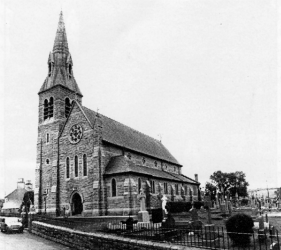
The Church of the Immaculate Conception,
Leitrim, was originally opened in August 1874. The granite
stone used for the building was drawn from the local
Ballymagreehan quarry.
Initiatives and Milestones
| 1784: |
Parish established. |
| 1786: |
First church erected in Leitrim - on the
present site. |
| 1834: |
School at Morgan's Barn in Legannany -
connected to the National Education Board. |
| 1835: |
Fr. Michael O'Loughlin P.P., repaired and
enlarged original church.
Ordnance Survey description - Plain, slated, rectangular
building.
Main dimensions - 60 by 50 feet,
Cross-shape. Contains open seats and gallery. |
| 1840: |
Plot of land purchased by Fr.
O'Loughlin P.P., for new cemetery, adjoining church. |
| 1842: |
On 13th. March, Fr. Theobald Matthew, the
famous temperance priest, preached a sermon in
newly-extended church. Collection taken up to help clear
debt incurred by enlargement. |
| 1857: |
New parochial house erected by Fr. A.J.
Finnegan P.P., on site of present house. |
|
1871-74: |
Fr. A.J. Finnegan, P.P., erected new church
on original site. Main building erected first and spire
finished in 1874. Granite stone - quarried locally. Cost of
church less spire -�2.891.19p. Official opening and
dedication on 2nd. August 1874, by Fr. John Lowry P.P |
| 1893: |
New school built at Legannany to replace
Morgan's Barn School. |
| 1924: |
Fr. McGivern P.P., repaired and
structurally improved parochial house. |
|
1924-26: |
Church completely redecorated and
gracefully adorned with many fine embellishments - mosaic
sanctuary floor, marble steps to the altars. Stations of the
Cross and Lourdes stained-glass windows were the gifts of
Mrs. McEvoy of Ballymagreehan.
The mosaic church floor, marble font and brass gates of the
Baptistry were donated by Mrs. & Mrs. Owen McCartan and
their daughter, Mary, of Ballydrumman, Leitrim. Mr. & Mrs.
James McNulty, Benraw, presented Baptistry windows.
Mr. John Owens, Backaderry, donated the stained-glass window
depicting the Resurrection. |
| 1929: |
The Lourdes Grotto, a gift from Mr. & Mrs
Patrick Owens, Belfast, and formerly of Backaderry, was
consecrated by Dr. Mulhern, Bishop of Dromore, on the 26th.
May. |
| 1964-66: |
Fr. James Mooney, P.P., erected new
parochial house on the site of the old one. |
| 1969-70: |
Exterior of church sand-blasted
and internal refurbishment undertaken. |
| 1971: |
Centenary of church celebrated on Sunday
10th. October.
Celebrants of the Mass were Fr. James Mooney, P.P., Fr.
Michael O'Rourke, P.P., Dromara & Canon Alex McMullan; the
latter two being natives of the parish. Church was filled to
overflowing for this momentous occasion and the special
sermon was preached by Fr. O'Rourke. |
| 1972: |
Listed building status was conferred on the
church by Department of Environment for N.I |
| 1993: |
Closure of Legannany Primary School.
Retirement of Fr. Mooney, P.P. |
| 1998-99: |
Extensive renovation to the 125 year-old
church, commenced on 3rd. February. Work was well on the way
to completion when disaster struck in the early hours of
2nd. Jul: 1998. The church was targeted by Loyalist
arsonists and suffered damage which necessitated its
closure. Work did not recommence until 12th. January 1999
and was finally completed in December of that year. On the
5th. December, before a packed congregation, Most Rev. John
McAreavey, Bishop of Dromore, rededicated the magnificently
refurbished Church of the Immaculate Conception. |
| 1999: |
New car-park completed.
New cemetery entrance opened and access road completed.
Drainage scheme undertaken in cemetery. |
| 2002: |
Granite monument with inscription
erected in church grounds to commemorate all still-born
babies buried there. |
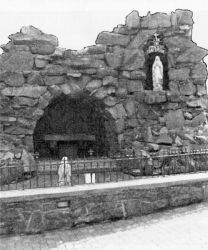 |
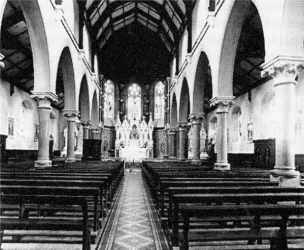 |
|
This Lourdes Grotto in the grounds of
Leitrim Church was solemnly blessed in May 1929 by
Bishop Mulhern. |
The Church at Leitrim was refurbished
1969-70. in advance of its centenary. This photograph
shows the interior of the Church at that time. |

UPPER DRUMGOOLAND - PARISH
PRIESTS
Following the establishment of the new Parish of
Upper Drumgooland in 1784, the Rev. Fergus Rooney was appointed
as its first Parish Priest. It is likely that he was the same Fr. Rooney
who was mentioned in a 1762 Vatican document as claiming jurisdiction in
Drumgooland, along with Fr. Michael Morgan. His successor in 1785, as
Parish Priest, was the Rev. Patrick McKay, who built the first
small church in Leitrim on the present site.
The Rev. Peter McEvoy, a native of Lowe
Drumgooland, was Parish Priest from 1808 - 1825 and was succeeded by the
Rev. Thomas O'Hare, who was an eloquent preacher.
The Rev. Michael O'Loughlin was appointed
Parish Priest of Upper Drumgooland in 1827 However, there is confusion
about the length of time he served in the Parish. Diocesan records have
him still in the parish up to 1850. However, according to the parish
register, Fr. John Mooney was the Parish Priest (or Administrator ) in
1846, a fact that is corroborated by other contemporary documents. It
seems that Fr. O'Loughlin either resigned or retired about this time.
Fr. John Mooney continued to administer the parish until the end of
1850. Along with Fr. Morgan of Lower Drumgooland, he attempted to
discourage the Catholic "Ribbonmen" from opposing the Orange march over
Dolly's Brae in 1849 and appeared before the subsequent investigation in
Castlewellan.
The Rev. John Mackin, became the next Parish
Priest in 1851. He died on a sea journey to America in 1855.
The Rev. Arthur J. Finnegan born in
Ballymaginthy, Lower Drumgooland, became Parish Priest of Upper
Drumgooland in November 1855, and served in the Parish until 1885 when
he was transferred to St. Peter's, Lurgan. A distinguished theologian
and classical scholar, he accepted the invitation of Dr. Leahy, Bishop
of Dromore, to act as President of St. Colman's College, Newry, from
1864 - 1866. Fr. Finnegan is stated to have possessed all the virtues
that adorn the life of a good and faithful priest. A glorious monument
to his zeal and efficiency was the erection of the new church at
Leitrim, one of the most beautiful examples of Gothic architecture in
the Diocese of Dromore. The church was opened on the 2nd.
August 1874.
The Rev. John Lowry, a native of Clonduff, was
Parish Priest from 1885 - 1906. In 1893 he opened a new school at
Legannany to replace the existing school. His brother, Fr. Andrew Lowry
succeeded him as Administrator of the parish until the appointment of
the new Parish Priest in 1907, the Rev. Patrick Quail. Fr. Quail
was born in Derryneil, Lower Drumgooland. He died in 1912 and was
interred in Leitrim. His brother, the Rev. John Quail, was appointed
Parish Priest on the 5th. May 1912. He was promoted to Canon in 1920,
died in 1924, and was also interred in Leitrim.
The subsequent Parish Priest, the Rev. Edward
McGivern, a native of Seapatrick, was largely responsible for
transforming the interior of the St. Mary Immaculate Church during his
seven-year pastorate. It was at this time that the mosaic work,
stained-glass windows and the beautifully executed mosaic Stations of
the Cross were installed, paid for principally by the generosity of the
parishioners.
The Rev. John Carr replaced Fr. McGivern as
Parish Priest in 1931 but was transferred to Lawrencetown in 1932 and
was succeeded by the Rev. John Doran, a native of Magheralin, who
served the parish well, until 1936. From then until 1941, the Rev.
David Gallery was Parish Priest.

Fr. ,Joseph Byrne, a native of Dromore, was
appointed Parish Priest in 1941 in succession to Fr. Gallery. Fr. Byrne
served as Parish Priest until his death in 1952 and was interred in
Leitrim.
The next Parish Priest of Drumgooland Upper was
Fr. Michael McCartan who was returning to his
native Parish. "Fr. Mick," as he was popularly known, served the parish
for eleven years, until his sudden death on the 20th. September 1963.
Very soon after his home-coming, Fr. Mick seemed to almost immediately
strike a chord with the people of the Parish. Apart from the fact that
he was a native son, well-known to both young and old, he came from
farming-stock which accustomed him to the rural way of life and gave him
a natural affinity to those who lived and worked on the land. Added to
this was his love for Gaelic games and culture, an interest he could
share with many of his parishioners. At his funeral Mass, the panegyric
was preached by another native of the parish, Fr. Michael O'Rourke C.C.,
Derrytrasna. Of Fr. Mick, he said;
"He was an unassuming, shy and retiring man,
always avoiding the limelight, always shunning publicity.
But beneath a modest exterior was a priest who was kindly and
understanding, a priest for whom no inconvenience was too great when
a friend needed help. He was particularly devoted to the sick and
the dying, and his kindly smile, ready wit and cheery
word, often brought them great consolation. He was above all, a man
of the people, not Merely interested in their spiritual
affairs, as was his duty as a priest, but quietly interested in all
their temporal undertakings."
Fr. Mick was laid to rest in the adjoining cemetery,
close to his beloved people and his native place.
His successor was Fr. James Mooney, a native
of Dromore, who was educated at the Irish College in Rome and ordained
there in the Chapel of the French College on the 26th. May 1935. Fr.
Mooney, having been appointed in 1963, served as Parish Priest of
Drumgooland Upper for 30 years, until his retirement in 1993. The early
period of his long incumbency coincided with the introduction of major
liturgical change, following the directives of the Second Vatican
Council, 1962-1965.
In 1966, Fr. Mooney moved into the new parochial
house which was erected on the site of the original building. Over the
next few years, he set about raising sufficient funds to refurbish the
Church of the Immaculate Conception and St. Patrick, in preparation for
the centenary celebrations of 1971. With the assistance of a dedicated
committee, Fr. Mooney organised a series of annual carnivals, featuring
leading show-bands of the time, to raise the necessary funds for the
church refurbishment.
In 1970, the exterior of the church received a major
face-lift, to re-invigorate the granite facade. Interior repairs to the
church were also undertaken at this time.
Towards the end of Fr. Mooney's tenure, the parish
suffered a severe blow with the closure of Legannany
School, the only school serving the parish. Despite
communal efforts to halt the process, the decline in the school-going
population made closure inevitable. This sad event, coincided in 1993,
with the retirement of Fr. Mooney who had been the longest serving
parish priest of Drumgooland Upper during the 20th. century. After
retirement, Fr. Jim kept in touch with the Parish and was a special
guest at the re-opening of the Church at Leitrim, following its
extensive refurbishment, in December 1999.

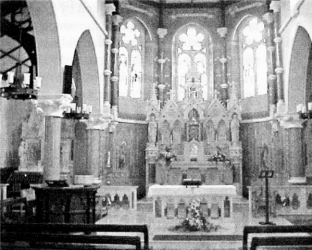
An extensive renovation of Leitrim
Church was carried out 1998-99. During the project the
church suffered an arson attack, in July 1998. It was
eventually completed and the sanctuary rededicated in
December 1999.
His last visit to Leitrim was on the 29th. September
2002, at the special invitation of the present parish priest, Fr. Frank
Lyons, on the occasion of Fr. Frank's induction Mass as Parish Priest of
Leitrim. The two priests had been friends for more than 20 years. Fr.
Jim died on the 4th. February 2003, and was interred in the local
cemetery.
Fr. James Kerr succeeded Fr. Mooney as Parish
Priest of Drumgooland Upper, serving there from the 14th. September
1993, until his untimely death, aged 55 years, on the 29th. August 1995.
A native of Lurgan, he was educated at St. Colman's College, Newry, and
Maynooth. After ordination, he spent much of his early ministry in the
field of education and specialised in the teaching of religion, having
completed a post-graduate course in Catechetics. He served on the staff
of both St. Colman's College and the Abbey Grammar School, Newry, and
was a curate at Rostrevor, before his appointment as Parish Priest of
Drumgooland Upper. He died suddenly on the 29th. August 1995 and was
interred at Lurgan.
Fr. Patrick McManus, a priest of the Columban
Fathers' Mission to China, administered the parish until the appointment
of Fr. Lionel Murray as Administrator on the 6th. September 1997.
A native of Ballynahinch, Fr. Murray was educated at St.
Colman's College, Newry and All Hallows College, Dublin, where in 1953,
he was ordained for the Diocese of Salford, in Manchester.
On the 3rd. February 1998, soon after Fr. Murray's
appointment to the parish, work commenced on major renovations to the
125 year-old Church in Leitrim.
However, disaster struck on the 2nd. July of that
year when the church was so badly damaged in a Loyalist arson attack
that it had to be immediately closed.
For the next 16 months, Sunday Mass was celebrated in
the G.A.A. hall at Fontenoy Park. Work on the church did not resume
until January 1999 and was finally completed in early December of that
year.
At the re-opening and dedication ceremony on Sunday
the 5th. December, Bishop John McAreavey announced Fr. Murray's
appointment as Parish Priest, much to the delight and appreciation of
the packed congregation.
Regrettably, failing health cut short Fr. Murray's
ministry in the Parish, prompting his retirement on the 17th. February
2002. During his relatively brief tenure in the parish, Fr. Murray
earned the love and respect of his parishioners, not only for the manner
in which he handled the extensive church renovations but, more
importantly, for the manner in which he discharged his priestly duties.
A man of deep faith and humility, blessed with a sense of humour and a
warmth of personality, he will be fondly remembered by the people of
Drumgooland Upper.
Archdeacon Liam Boyle, Parish Priest of Lower
Drumgooland was appointed Administrator on the retirement of Fr. Murray,
until the appointment of the present Parish Priest, Fr. Frank Lyons on
the 23rd. August 2002.
Fr. Frank, as he prefers to be called, is a native of
Turner's Cross, in Cork City. Educated in infancy by the Presentation
Sisters and then by the Presentation Brothers, Turner's Cross, in 1953
he went to study at St. Patrick's Missionary Society, Kiltegan, Co.
Wicklow. He was ordained on Easter Sunday the 17th. April 1960, and
appointed to the Diocese of Ogoja, in Eastern Nigeria. He remained in
Nigeria for 18 years. In 1979, he requested a Sabbatical Year as curate,
in a rural parish in Ireland. His request was granted and, in November
1979, he came on loan to the Diocese of Dromore. In 1997, Bishop Francis
Gerard Brooks incardinated Fr. Frank into the Diocese of Dromore.

LAY ORGANISATIONS OF
UPPER AND LOWER DRUMGOOLAND
The number of lay organisations within the parishes
of Upper and Lower Drumgooland has varied over the years. Some
committees such as those formed for fund-raising purposes have usually
lasted until objectives have been achieved, whereas other bodies such as
the Pioneer Association and those involved in
Apostolic Work have endured for much longer. Finance
and Cemetery Committees have done sterling work in both parishes of
Drumgooland, over the past number of years, supervising the extensive
refurbishment of the churches in Leitrim, Gargory and Dechomet and the
cemeteries at Leitrim and Dechomet. It is the unselfish commitment and
dedication of the men and women working within these organisations, from
year to year, that helps ensure their parishes continue to function as
cohesive and vibrant units.
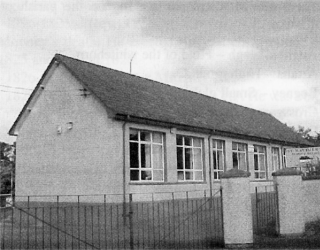 |
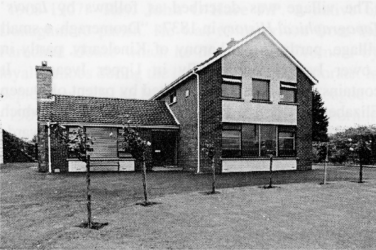 |
|
Magheramayo Primary School was opened in
1953. It became known as St. Matthew's School in recent
years. Along with St. Mary's School, Dechomet, it serves
both Drumgooland parishes. Legannany School, in Upper
Drumgooland, closed in 1993. |
The original Parochial House at Leitrim was
built in 1857. It was replaced by the existing house which
Fr. James Mooney, P.P. had erected. The old house was
demolished in April 1966 and the new house opened in
December of that year. |
 |
